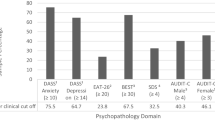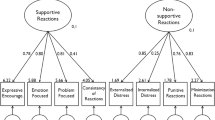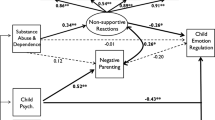Abstract
The current study examined the moderating influence of observed parental emotion socialization (PES) on self-medication in adolescents. Strengths of the study include the use of a newly developed observational coding system further extending the study of PES to adolescence, the use of an experience sampling method to assess the daily covariation between negative affect and substance use, and a focus on PES styles defined by the interaction of emotion-dismissing and emotion-coaching behaviors. Using multi-leveling modeling, we tested PES as a moderator of daily negative mood-substance use relation in a sample of 65 elevated-risk adolescents (48% male, 58% Caucasian, with a median age of 14). Results showed a three-way interaction between emotion-coaching PES, emotion-dismissing PES and daily negative mood in predicting daily substance use. Results are discussed in terms of the importance of PES styles and their effects on self-medication through compromised emotion regulation and interpersonal processes.


Similar content being viewed by others
Notes
We selected EC standard deviations of ±0.5 and ±1.0 given the small number of adolescents with parents who demonstrated EC behaviors well beyond one standard deviation above or below the mean (i.e., 17% and 19% of sample with parents respectively showing EC behaviors less than and greater than one standard deviation below and above the mean.
Two alternative patterns of increased likelihood for daily substance use emerged from the interactional effects of emotion-coaching and punitive PES responses, both not conforming to self-medication. First, adolescents whose parents demonstrated relatively low levels EC behaviors combined with an absence of punitiveness (i.e., disengaged PES style) were at relatively uniform risk for substance use on any given day regardless of the level of negative mood they were experiencing (see Fig. 1). Second, adolescents whose parents demonstrated a presence of punitiveness but with the lowest levels of EC response (i.e., punitive-low coaching PES style) were at slightly elevated risk for daily substance use regardless of negative mood experienced within a given day. However, due to the low predicted probabilities of substance use and the small subgroup of adolescents (N = 6; 9% of sample) driving such an effect, we do not interpret these findings any further.
References
Allen, J. P., Hauser, S. T., Eickholt, C., Bell, K. L., & O’Conner, T. G. (1994). Autonomy and relatedness in family interactions as predictors of expressions of adolescent negative affect. Journal of Research on Adolescence, 4(4), 535–552. doi:10.1207/s15327795jra0404_6.
Angold, A., Costello, E. J., Messer, S., & Pickles, A. (1995). International Journal of Methods in Psychiatric Research, 5(4), 237–249.
Barber, B. K., & Olsen, J. A. (2004). Assessing the transitions to middle and high school. Journal of Adolescent Research, 19(1), 3–30. doi:10.1177/0743558403258113.
Barnes, H. L., & Olson, D. H. (1982). Parent–adolescent communication scale. In D. H. Olson, et al. (Ed.), Family inventories: Inventories used in a national survey of families across the family life cycle (pp. 33–48). St. Paul: Family Social Science, University of Minnesota.
Bateson, G., Jackson, D. D., & Haley, J. A. (1962). A note on the double bind. Family Process, 2(1), 154–161. doi:10.1111/j.1545-5300.1963.00154.x.
Bauer, D. J., & Curran, P. J. (2005). Probing interactions in fixed and multilevel regression: Inferential and graphical techniques. Multivariate Behavioral Research, 40(3), 373–400. doi:10.1207/s15327906mbr4003_5.
Baumrind, D. (1991). The influence of parenting style on adolescent competence and substance use. The Journal of Early Adolescence, 11(1), 56–95. doi:10.1177/0272431691111004.
Belsky, J., Lerner, R. M., & Spanier, G. B. (1984). The child in the family. Topics in Developmental Psychology. Reading, PA: Addison-Wesley.
Bloom, B. L. (1985). A factor analysis of self-report measures of family functioning. Family Process, 24(2), 225–239. doi:10.1111/j.1545-5300.1985.00225.x.
Brand, A. E., Mulvihill, J., Klimes-Dougan, B., Usher, B. A., & Zahn-Waxler, C. (2005). Parent-adolescent conversations regarding sad and worrisome past events: The emotional discussion coding system. Poster presented at the biennial meeting of the Society for Research in Child Development, Atlanta, GA (April).
Bryk, A. S., & Raudenbush, S. W. (1992). Hierarchical linear models. Applications and data analysis methods. Advanced Quantitative Techniques in the Social Sciences, 1. Thousand Oaks: Sage.
Calkins, S. D., & Bell, K. L. (1998). Developmental transitions as windows to parental Socialization of emotion. Psychological Inquiry, 10(4), 368–372.
Caron, A., Weiss, B., Harris, V., & Catron, T. (2006). Parenting behavior dimensions and child psychopathology: Specificity, task dependency, and interactive relations. Journal of Clinical Child and Adolescent Psychology, 35(1), 34–45. doi:10.1207/s15374424jccp3501_4.
Chassin, L., Hussong, A., Barrera Jr, M., Molina, B. S. G., Trim, R., & Ritter, J. (2004). Adolescent substance use. In R. M. Lerner, & L. Steinberg (Eds.), Handbook of adolescent psychology (pp. 665–696, 2nd ed.). Hoboken: Wiley.
Conger, J. J. (1956). Alcoholism: Theory, problem and challenge. Reinforcement theory and the dynamics of alcoholism. Quarterly Journal of Studies on Alcohol, 13, 296–305.
Conger, R. D., & Ge, X. (1999). Conflict and cohesion in parent–adolescent relations: Changes in emotional expression from early to mid-adolescence. In M. Cox, & J. Brooks-Gunn (Eds.), Conflict and cohesion in families: Causes and consequences. The advances in family research series (pp. 185–206). Mahwah, NJ: Erlbaum.
Cooper, M. L. (1994). Motivations for alcohol use among adolescents: Development and validation of a four-factor model. Psychological Assessment, 6(2), 117–128. doi:10.1037/1040-3590.6.2.117.
Cooper, M. L., Russell, M., Skinner, J. B., Frone, M. R., & Mudar, P. (1992). Stress and alcohol use: Moderating effects of gender, coping, and alcohol expectancies. Journal of Abnormal Psychology, 101(1), 139–152. doi:10.1037/0021-843X.101.1.139.
Curran, P. J., Bauer, D. J., & Willoughby, M. T. (2006). Testing and probing interactions in hierarchical linear growth models. In C. S. Bergeman, & S. M. Boker (Eds.), Methodological issues in aging research. Notre Dame series on quantitative methods (pp. 99–129). Mahwah, NJ: Erlbaum.
Dix, T. (1991). The affective organization of parenting: Adaptive and maladaptive processes. Psychological Bulletin, 110(1), 3–25. doi:10.1037/0033-2909.110.1.3.
Eisenberg, N., Fabes, R. A., & Murphy, B. C. (1996). Parents’ reactions to children’s negative emotions: Relations to children’s social competence and comforting behavior. Child Development, 67, 2227–2247. doi:10.2307/1131620.
Eisenberg, N., Cumberland, A., & Spinrad, T. L. (1998). Parental socialization of emotion. Psychological Inquiry, 9(4), 241–273. doi:10.1207/s15327965pli0904_1.
Feagans Gould, L. A., Hussong, A. M., & Hersh, M. A.(2007, March). Self-medication in adolescence: Examining sub-populations at risk. Poster presented at the biennial meeting of the Society for Research on Child Development. Boston, MA.
Feldstein, S. W., & Miller, W. R. (2006). Substance use and risk-taking among adolescents. Journal of Mental Health, 15(6), 633–643. doi:10.1080/09638230600998896.
Fivush, R. (1998). Methodological challenges in the study of emotion socialization. Psychological Inquiry, 9(4), 281–283. doi:10.1207/s15327965pli0904_5.
Garside, R. B., & Klimes-Dougan, B. (2002). Socialization of discrete negative emotions: Gender differences and links with psychological distress. Sex Roles, 47(3–4), 115–128. doi:10.1023/A:1021090904785.
Glezerman, A. (2000). Family interaction and adolescents’ coping and defensive processes. Dissertation, California School of Professional Psychology, Alameda
Gondoli, D. M., & Braungart-Rieker, J. M. (1998). Constructs and processes in parental socialization of emotion. Psychological Inquiry, 9(4), 283–285. doi:10.1207/s15327965pli0904_6.
Gottman, J. M., Katz, L. F., & Hooven, C. (1997). Meta-emotion: How families communicate emotionally. Hillsdale, NJ: Erlbaum.
Halberstadt, A. G. (1991). Socialization of expressiveness: Family influences in particular and a model in general. In R. S. Feldman, & B. Rime (Eds.), Fundamentals of emotional expressiveness (pp. 106–162). Cambridge: Cambridge University Press.
Hersh, M. A. (2006). Behavioral Coding System of Parental Reactions to Adolescents’ Stress. Unpublished coding manual. Chapel Hill, NC: University of North Carolina–Chapel Hill.
Hersh, M. A., & Hussong, A. M.(2006, March). Observed parental emotion socialization and adolescent daily affective stability. In M. A. Hersh (Chair), Parental emotion socialization in adolescence: Links to adolescent emotional processes and adjustment. Paper symposium accepted for the biennial meeting of the Society for Research on Adolescence, San Francisco, CA.
Hussong, A. M., & Chassin, L. (1994). The stress-negative affect model of adolescent alcohol use: Disaggregating negative affect. Journal of Studies on Alcohol, 55, 707–718.
Hussong, A. M., Feagans Gould, L., & Hersh, M. A. (2008). Conduct problems moderate self-medication and mood-related drinking consequences in adolescents. Journal of Studies on Alcohol and Drugs, 69(2), 296–308.
Ingram, R. E., Bailey, K., & Siegle, G. (2004). Emotional information processing and disrupted parental bonding: Cognitive specificity and avoidance. Journal of Cognitive Psychotherapy, 18(1), 53–65. doi:10.1891/jcop.18.1.53.28051.
Jacob, T., & Johnson, S. (1997). Parenting influences on alcohol abuse and dependence. Alcohol Health and Research World, 21(3), 204–209.
Johnston, L. D., O’Malley, P. M., Bachman, J. G., & Schulenberg, J. E. (2007). Monitoring the Future national survey results on drug use, 1975–2006. Volume I: Secondary school students (NIH Publication No. 07-6205). Bethesda, MD: National Institute on Drug Abuse.
Juang, L. P., & Silbereisen, R. K. (1999). Supportive parenting and adolescent adjustment across time in former East and West Germany. Journal of Adolescence, 22(6), 719–736.
Kandel, D. B., & Davies, M. (1982). Epidemiology of depressed mood in adolescents. Archives of General Psychiatry, 39, 1205–1212.
Katz, L. F., & Hunter, E. C. (2007). Maternal meta-emotion philosophy and adolescent depressive symptomatology. Social Development, 16(2), 343–360. doi:10.1111/j.1467-9507.2007.00388.x.
Katz, L. F., Wilson, B., & Gottman, J. M. (1999). Meta-emotion philosophy and family adjustment: Making an emotional connection. In M. Cox, & J. Brooks-Gunn (Eds.), Conflict and cohesion in families: Causes and consequences. The advances in family research series (pp. 131–165). Mahwah, NJ: Erlbaum.
Katz, L. F., & Windecker-Nelson, B. (2004). Parental meta-emotion philosophy in families with conduct-problem children: Links with peer relations. Journal of Abnormal Child Psychology, 32(4), 385–398. doi:10.1023/B:JACP.0000030292.36168.30.
Lubin, B., Denman, N., & Van Whitlock, R. (1998). Measuring the mood of seventh-grade students with the MAACL-R6. Adolescence, 33, 583–590.
Lunkenheimer, E. S., Shields, A. M., & Cortina, K. S. (2007). Parental emotion coaching and dismissing in family interactions. Social Development, 16(2), 232–248. doi:10.1111/j.1467-9507.2007.00382.x.
Mahoney, A., Coffield, A., Lewis, T., & Lashley, S. L. (2001). Meso-analytic behavioral rating system for family interactions: Observing play and forced-compliance tasks with young children. In P. K. Kerig, & K. M. Lindahl (Eds.), Family observational coding systems: Resources for systemic research. Mahwah, NJ: Erlbaum.
Miller, P. A., Kliewer, W., Hepworth, J. T., & Sandler, I. N. (1994). Maternal socialization of children’s postdivorce coping: Development of a measurement model. Journal of Applied Developmental Psychology, 15(3), 457–487.
Montemayor, R., Eberly, M., & Flannery, D. J. (1993). Effects of pubertal status and conversation topic on parent and adolescent affective expression. Journal of Early Adolescence, 13(4), 431–447.
Morris, A. S., Silk, J. S., Steinberg, L., Myers, S. S., & Robinson, L. R. (2007). The role of the family context in the development of emotion regulation. Social Development, 16(2), 361–388.
Nystul, M. S. (2002). Emotional balancing: A parenting technique to enhance parent–child relationships. The family psychology and counseling series. In R. E. Watts, & J. Carlson (Eds.), Techniques in marriage and family counseling, Vol. 2 (pp. 125–131). Alexandria, VA: American Counseling Association.
Patterson, J. M., & McCubbin, H. I. (1987). Adolescent coping styles and behaviors: Conceptualization and measurement. Journal of Adolescence, 10(2), 163–186.
Raudenbush, S. W., & Bryk, A. S. (2002). Hierarchical liner models: Applications and data analysis methods (2nd ed.). Newbury Park, CA: Sage.
Raudenbush, S., Bryk, A., Cheong, Y. F., & Congdon, R. (2004). HLM 6: Hierarchical linear and nonlinear modeling. Lincolnwood, IL: Scientific Software International.
Seidman, E., Aber, J. L., Allen, L., & French, S. E. (1996). The impact of the transition to high school on the self system and perceived social context of poor urban youth. American Journal of Community Psychology, 24, 489–515.
Sheeber, L., Davis, B., Hops, H., & Leve, C. (2003). Parental influences on adolescent emotion regulation. An indirect model of adolescent depression. Paper presented to the biennial meeting of the Society for Research in Child Development. Tampa, FL.
Shortt, J. W., Smith, J., & Stoolmiller, M. (2006). Maternal socialization and emotion regulation in middle school siblings. Paper presented at the biennial meeting of the Society for Research on Adolescence. San Francisco, CA.
Steinberg, L., Mounts, N., Lamborn, S., & Dornbusch, S. (1991). Authoritative parenting and adolescent adjustment across various ecological niches. Journal of Research on Adolescence, 1, 19–36.
Wills, T. A., & Filer, M. (1996). Stress-coping model of adolescent substance use. In T. H. Ollendick, & R. J. Prinz (Eds.), Advances in clinical child psychology, Vol. 18 (pp. 91–132). New York: Plenum.
Wills, T. A., Blechman, E. A., & McNamara, G. (1996a). Family support, coping, and competence. In E. M. Hetherington, & E. A. Blechman (Eds.), Stress, coping, and resiliency in children and families (pp. 107–134). Mahwah: Erlbaum.
Wills, T. A., Mariani, J., & Filer, M. (1996b). The role of family and peer relationships in Adolescent substance use. In G. R. Pierce, B. R. Sarason, & I. G. Sarason (Eds.), Handbook of social support and the family (pp. 521–549). New York: Plenum.
Zahn-Waxler, C., Klimes-Dougan, B., & Kendziora, K. T. (1998). The study of emotion socialization: Conceptual, methodological, and developmental considerations. Psychological Inquiry, 9(4), 313–316.
Author information
Authors and Affiliations
Corresponding author
Rights and permissions
About this article
Cite this article
Hersh, M.A., Hussong, A.M. The Association Between Observed Parental Emotion Socialization and Adolescent Self-Medication. J Abnorm Child Psychol 37, 493–506 (2009). https://doi.org/10.1007/s10802-008-9291-z
Published:
Issue Date:
DOI: https://doi.org/10.1007/s10802-008-9291-z




